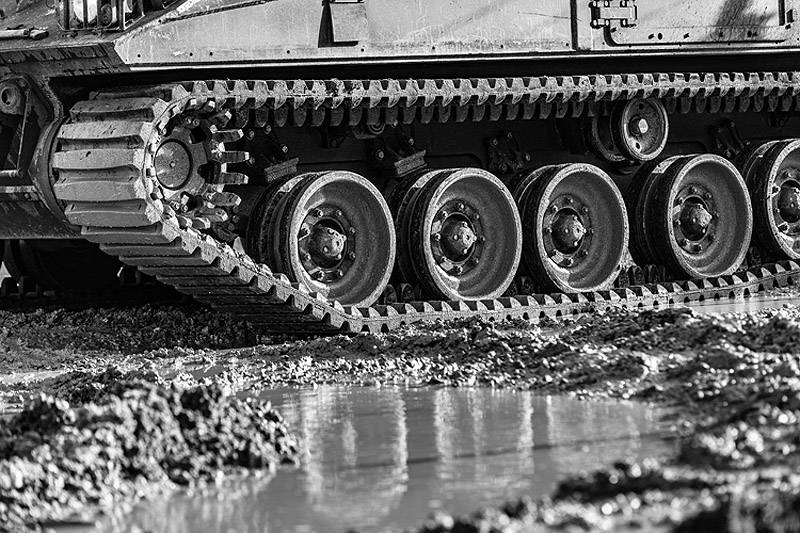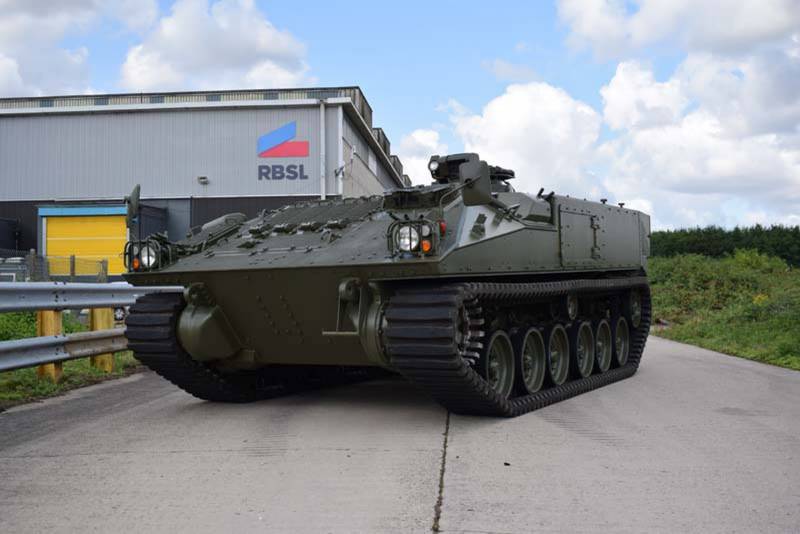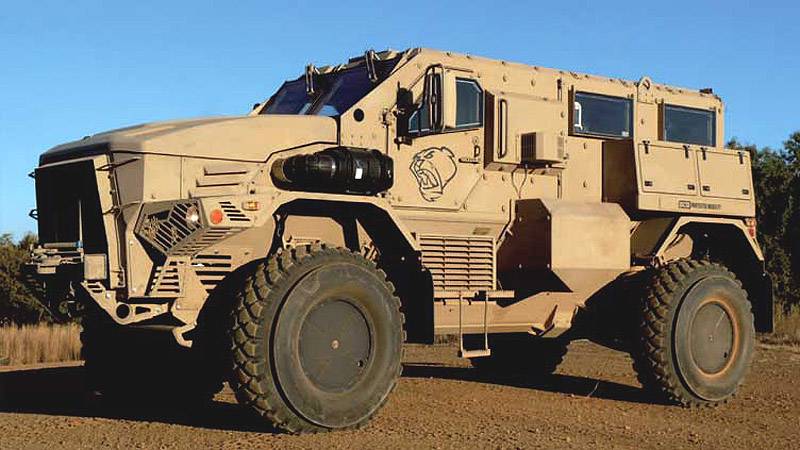Caterpillar or Wheel: The Eternal Dilemma

The British Warrior infantry fighting vehicle equipped with Soucy rubber caterpillars is undergoing intensive tests to confirm the concept of using them on medium-weight armored vehicles
In the community of operators of armored vehicles, it seems that the debate about the relative advantages and disadvantages of wheels and tracks will never end. Take a closer look at the potential benefits that each type of mover provides.
The need for platforms that can move around terrain of any type and act on the battlefield in the same battle formations with heavy armored vehicles, as a rule, determines the installation of a caterpillar mover. At the same time, medium and light armored vehicles, which usually drive on roads and which must be airborne to accelerate deployment, are usually wheeled.
The selection problem is complicated in the case of medium-sized platforms. The mass of these machines is increasing due to changes in operational requirements, and depending on the technological development of tracks and wheels, which can improve performance and mitigate any shortcomings, each type of mover can get an advantage here.
Steel does not give up
Tracked systems dominate the market for armored vehicles heavier than 30 tons, and although steel tracks still dominate, manufacturers of composite rubber equivalents are trying to gain a foothold in this market. The development of steel caterpillars is mainly associated with weight reduction. This is achieved through the use of lighter materials that can withstand the forces acting on them. First of all, they can be obtained through the development of special grades of high-strength steel.
William Cook, commercial director of Cook Defense Systems (CDS), a steel track developer and manufacturer, said they offer lighter options for their customers, including the British Army. CDS also supplies all components that are somehow connected to the tracks themselves, including drive sprockets, steering wheels, track and support rollers, etc.
He explained:
In the mass production process, CDS provides high quality products and guarantees the absence of defects due to X-ray inspection of 100% of the tracks. The company also provides a complete set of tools for assembly and maintenance with relevant instructions, and also sends technical teams to military units that advise and assist the crews of vehicles.
Steel tracks can be in the variant with one or two fingers. The difference is that the tracks are connected by either one or two fingers. One-finger tracks weigh less and provide good grip, which is why they are more suitable for light vehicles. Two-finger tracks are heavier and more suitable for tanks, but do not always provide similar characteristics, while they are also more expensive.
In steel tracks, the fingers are usually rubberized, that is, covered with a small layer of rubber, and this determines the service life of the tracks. A caterpillar with two rubberized fingers wears out twice the amount of rubber. CDS has invested considerable efforts and resources in research and development in the field of special wear-resistant rubber compounds used for the manufacture of fingers, pads and cleaners.
“Improving the performance of rubber compounds is very important to extend the life of the track," Cook said. CDS has at its disposal a specialized laboratory for testing and quality control of rubber compounds at the track production plant, and also works closely with British universities to develop more flexible rubber compounds.
Recently, the company also invested $ 6,4 million in its UK operations with the goal of moving all metal components into production and reducing dependence on third-party parts supplies, including fingers and staples. This has improved the rhythm of deliveries of tracks to the British army of its own production, which is very important, because the tracks are a highly consumable component during military operations and are extremely necessary to maintain the performance of armored vehicles.
Cook said that if the operators of armored vehicles ultimately want to have “full combat capabilities,” they cannot abandon the steel tracks because they allow you to overcome the most difficult terrain, including marshy soil and mud slopes.
Regarding medium-sized armored vehicles by mass, where the competition between steel and rubber tracks is most acute, Cook noted: “There will always be users who want to use their vehicles in large-scale military operations and therefore they will need steel tracks, but there will also be those who want to use "their vehicles in operations where it is necessary to travel long distances on various types of roads, or in peacekeeping operations or in support operations for which rubber tracks are more suitable."
Cook emphasized that since CDS is independent of the control of any developer or manufacturer of armored vehicles, such as BAE Systems or Krauss-Maffei Wegmann, it can offer its tracked systems to any manufacturer. CDS is working with Singaporean ST Engineering on the Hunter BBM, in the Middle East to modernize Russian cars, Turkish Otokar on its Tulpar BMP and German Rheinmetall on the Lynx BMP as part of the Australian Land 400 program.

Photo: SOUCY
For a project for a British combat support armored vehicle, a new mortar installation based on RBSL's Warrior armored vehicle was equipped with Soucy rubber caterpillars
Bridging the gap
Meanwhile, the performance of composite rubber tracks is constantly improving. Manufacturers want to compete not only with steel tracks in the field of heavy and medium armored vehicles, they also compete with wheeled solutions. Calvin Sloan of Soucy, a Canadian rubber track company, said his company is involved in most armored vehicle programs, and this is due to the opportunities offered by this type of track. “A long-standing debate on the topic“ Which is better: a caterpillar or a wheel? ”Always flared up again when it came to the mobility of armored vehicles. While the wheels, in particular the 8x8 cars, perform better on the road than steel tracks, the rubber tracks fit well in the niche between the wheels and the tracks. ”
Sloan explained that the road characteristics of rubber tracks allow a greater total distance that almost coincides with the mileage of the wheels, since the average distances between the breakdowns of the armored vehicles are approximately the same, but if you take a heavier car, then the rubber tracks actually provide greater mileage between the breakdowns.
Soucy is working on new brands of rubber compounds that will allow rubber tracks to work more efficiently on cars over 50 tons and will be able to challenge steel in the field of heavy armored vehicles. At present, Canada is undergoing operational tests of an obsolete Leopard 1 tank weighing approximately 42 tons, equipped with rubber tracks.
We experiment with this composition, derive the dependences on the mass of the machine so that it exactly matches it. As a rule, we make a truck from six different mixtures and then drive it on our Leopard test tank, analyze which segment works best and then take it and make a complete track out of it. Soucy is working on its latest formulations, which are specifically designed for machines weighing about 55 tons, and conducts tests to measure heat dissipation. ”
Sloan added that the company is located approximately two years from achieving practical results. Meanwhile, the target market for composite rubber tracks is medium vehicles weighing 35-48 tons. He noted that tracked platforms have better combat stability compared to explosive-sensitive wheeled vehicles, since a rubber track can absorb the blast wave. The probability of damage to steel tracks from an explosion is higher, while they create secondary damaging factors in the form of steel fragments.
According to Sloan, other advantages of rubber tracks include longevity, while rubberized steel tracks with glued rubber pads must be changed every 600 km. Steel tracks are also the cause of wear on drive wheels, sloths, track and support rollers, rubber pads, and of course the track links themselves. “With steel tracks, you are forced to change track rollers every 1500–2000 km, the same situation with rubber and rubber parts. The service life of the drive and guide wheels is 2000-3000 km, while for comparison, the rubber-rubber contact is much less destructive. "
The result of less wear and tear is a reduction in logistic support, which is another advantage along with a reduction in noise and vibration of up to 70%. Vibration can adversely affect combat systems, ammunition, electronics, and humans, as constant shaking over time leads to disastrous results. The use of rubber also reduces weight and improves fuel economy.
Competitive market
The company tested its composite rubber tracks on the British Army Warrior infantry fighting vehicle, initially to confirm the concept, and later as an offer for the Ajax program. At DSEI 2019, the company showed one of its mileage tracks and a new track on the Warrior for clarity. Sloan said the new tracks could be part of the Warrior BMP extension program if the Department of Defense wanted this, although no agreement has been received from him at this time. Rheinmetall BAE Systems Land (RBSL) uses Soucy rubber tracks on its Warrior mortar version for the British Armored Battlefield Support Vehicle program.
In September 2018, AS3 Redback vehicles from the South Korean company Hanwha Defense and Rheinmetall KF400 Lynx were selected as part of Phase 21 of the Australian Land 41 program for the new tracked infantry fighting vehicle. Soucy has its own rubber track for the AS21, and CDS has steel tracks for the Lynx. The wheeled platform was selected in an earlier Combat Reconnaissance Vehicle reconnaissance vehicle program, which turned out to be the Rheinmetall Boxer 8x8 APC.
The French army is often cited as an example of a military structure that replaced its tracked armored vehicles with wheeled ones, including medium armored personnel carriers and infantry fighting vehicles. This experience proved successful during operations in Mali, when wheeled armored vehicles and wheeled artillery were transferred to the capital of Senegal, Dakar, and then under their own power reached the Malian province of Gao.
Although not a single large army has followed the example of France, there is a clear tendency to purchase more mobile 8x8 wheeled vehicles of the middle weight category. Like Australia, the British Army chose Boxer for its Mechanized Infantry Vehicle program to replace the obsolete tracked FV430 armored personnel carriers.
Soucy installed its rubber track on the Malaysian army’s Adnan ACV-300 infantry fighting vehicle and, according to Sloan, they were approved by the United Nations for deployment in peacekeeping operations. The Soucy rubber track is also mounted on CV90s in two of the seven operating countries - Denmark and Norway.
Sloan emphasized:
Another look
While CDS and Soucy see the great potential of tracked vehicle programs, wheeled armored vehicle manufacturers see the market a little differently. Peter Simson of Tyron Runflat said that there are only two large programs for tracked infantry fighting vehicles - the American Next Generation Combat Vehicle and the Australian Land 400 - while there are many programs for wheeled armored vehicles, for example, the British Boxer 8x8.
Simson said that when using Tyron compound rubber resistant inserts, the availability of theater equipment is currently growing and that wheeled combat vehicles and support vehicles have no shortcomings and meet FINABEL Agreement pneumatic tire test standards. This standard is a strict set of criteria that wheels with military-resistant military-grade inserts should meet for various injuries.
The use of self-supporting wheels is very important, they allow the machine to continue its task in case of damage or flat tire.
- said Simson.
According to Simson, reinforced rubber tire sidewalls or inserts also play an important role, as they absorb shock and shock from various obstacles in rough terrain and provide reliable tire fixation.
Tyron’s All-Terrain Rubber Multi-Part (ATR-MP) inserts ensure tire retention, absorb shock and also reduce logistic load, since special mounting tools are not needed, that is, the tire can be replaced using standard tools. Simson noted that this was the reason why products with this technology are the company's most popular products.
ATR-MP insert is usually made of three parts, which are bolted to each other, ensuring a tight fit around the wheel. During installation, one of the tire beads is applied to the rim, then an impact-resistant insert is installed and finally a second bedlock is added. In the case of military-style wheels, the insert is usually made of two parts that are bolted together to ensure a secure fit. Composite inserts use a steel core to provide strength and rigidity, and the surrounding rubber ensures fixation and shock absorption.
- said Simson.
- he added.
At DSEI, the company introduced the Tyron ATR-SP (single-piece) solid rubber insert.

DCD Protected Mobility Springbuck 4x4 armored vehicle equipped with Tyron ATR high-speed wheels is being tested in South Africa
Expected Needs
Simson believes that due to the expanding market for wheeled armored vehicles, the demand for composite rubber inserts is correspondingly growing. Tyron also supplies products for Lugar and Milos armored vehicles from Yugoimlort, Springbuck and Mountain Lion vehicles from DCD Protected Mobility, Acmat Light Tactical Vehicle 4x4 and Timsah / Crocodile 4x4 Egyptian vehicle.
The French company Texelis, which manufactures the chassis of armored vehicles, believes that the French Scorpion program is a good example of the transition from tracked to wheeled vehicles. The main driver here is the need for increased mobility. This was announced by a company representative, noting that this transition is limited mainly to machines weighing less than 35 tons. The company received a contract to develop a Serval 4x4 machine for the French army.
According to Texelis, the increased mobility requirements of many armies are a reaction to the development of technologies such as swarming. drones, artificial intelligence and continuous surveillance on the battlefield. The company spokesman added that due to the development of power transmission technology, the wheels are becoming more reliable, “for example, complex suspension systems, centralized tire pressure control systems and internal anti-collision insert technologies.” This makes wheeled solutions more resilient and adaptable to a variety of environments, including combat in built-up areas.”
Despite the growing competition from rubber tracks, wheels are still being considered as the preferred choice for armored vehicles that move mainly on roads, but as the mass of these vehicles increases, the problem becomes more acute. The representative of Texelis noted:
The debate about what is best for armored vehicles, a caterpillar or a wheel, will continue further, as there is growing competition in the market for medium-class vehicles by weight. Technological development makes it difficult to decide on the choice of one propulsion, but it is beneficial to the military, since the mobility of armored vehicles will improve in any case.
Information